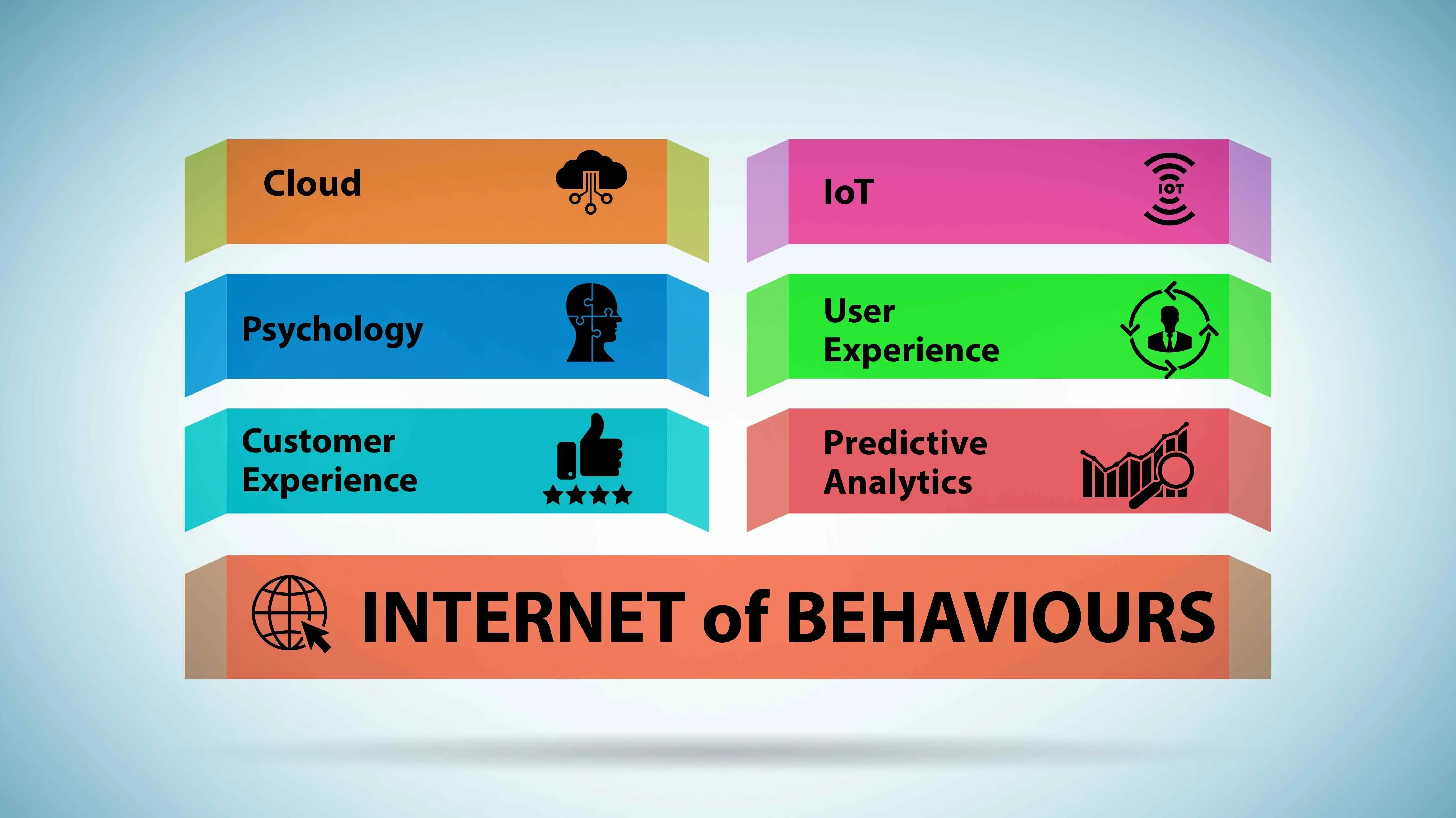The internet exists because it revolutionized how people communicate and access information. Made up of networks that communicate with each other, the Internet opened the doors to different innovations and one such concept is "the Internet of things."
IoT [internet of things], is a network of interconnected devices that exchange information and data with other devices and the cloud, it uses this innovation and the ability of devices connected to networks to communicate for various purposes that include data transmission, automation, etc.
The Internet of Behaviors extends from the Internet of Things (IoT). It leverages technologies like biometrics, and big data to analyze and understand how humans behave.
Let us explore the concept of the Internet of Behavior even further. Firstly, we’ll go through a brief understanding of IOT.
Internet of Things
IoT can also be called smart objects because it involves the network of physical devices embedded with software, sensors, and technologies to connect data from other systems and transmit data over a wireless network. Some of these devices/objects are smartphones, smart homes and appliances, industrial machines, etc.
IoT provides a foundation of understanding when learning about the Internet of Behaviors [IoB], an emerging technology slowly influencing the technological market.
However, to understand IoB you must also understand the Internet of Things [IoT], click here to find an article we wrote about it.
What is the Internet of Behaviors?
The Internet of Behaviors is a concept that uses data analytics to understand and predict human behavior. It involves analyzing data that provides information about users' behavior, interests, and preferences.
The Internet of Behaviors combines artificial intelligence, data analytics, IoT(Internet of Things), and other technologies including science to predict human behavior and make informed decisions.
According to Gartner, “Technology is changing the notion of what it means to be human in a digital world” The prediction for IT including users and organizations explores how technology is contemplating the human condition. Gartner predicts that by 2025, over half of the world's population will be subject to at least one IoB program.
In other words over 50% of the world would have been tracked digitally, and influenced by one IoB enterprise whether commercial or government.
The Internet of Behaviors aims to capture, analyze, and understand human behaviors. How we interact with certain products or services, who we interact with, our food preferences, our daily transactions, and so on.
Let’s think of the Internet of Behaviors similarly to consumer data profiling where companies leverage data to find customers' buying patterns, pain points, motivations, etc.
IoT provides a way to get data from different new data sources, IoT devices gather data from sensors, cameras, home appliances, beacons, smart watches, etc. Then IoB turns that data or information into valuable insights.
Such information is collected to improve efficiency and quality for different goals or objectives. For instance, behavioral data provides insights into the lifestyle of consumers which allows companies to make more strategic and informed decisions that may include;
- Personalized marketing campaigns.
- Customized products and services.
- Personalized user experience.
- Provide improvements to existing products.
Think about this for a moment, have you ever thought the internet must be reading your mind? One moment you’re on social media liking someone's comments about a product you’re interested in, and the next day you start seeing these products all over your for you page.
Or notice you’ve been getting recommendations about the type of movies you like on your Netflix recommendation, these are some of the ways companies can use clients' behavior for advertisement.
Stages of Internet of Behaviors
The different stages involved in the Internet of behaviors include;
Data Gathering: This is achieved using various platforms like; social media, websites, beacons, etc. For instance, websites can track how often a user visits a particular page, IoB takes the collected data and uses behavioral science/psychology to analyze the data which can be used to influence how businesses or organizations interact with individuals or groups.
Data Analysis: Data is collected and analyzed for various purposes e.g. data can be analyzed to make business decisions to drive sales or personalize marketing campaigns for customers based on purchasing patterns.
Behavioral Insight Processing: After data is analyzed, insights are generated based on humans' behavioral patterns and preferences, including social interactions, decision-making processes, consumption habits, etc.
Data is evaluated to make decisions, for instance, a business can create detailed profiles for their clients to get a more personalized experience.
Benefits of Internet of Behaviors
The importance of the Internet of Behaviors includes;
Data-Driven Decisions: By using IoB, business can leverage data to create and develop growth-focused strategies. An example would be the ability to create customized marketing patterns and curate purchasing incentives and individualized user experiences based on the past purchasing behaviors of customers.
Personalized Services: Companies can target their services promptly to influence the decisions of their customers. Giving customers access to their preferences can enhance the user experience and lead to an increase in sales.
Environmental Benefits: IoB can promote environmental benefits indirectly. Let’s use the smart pantry as an example, this idea has been developed by different individuals to track purchases and the use of household groceries for families to reduce food waste.
Internet of Behaviors Concerns
Privacy: There are concerns about how data is gathered, whether consent was granted, whether users were informed, and so on.
Cyber Security: The risk of a data breach is a cause for concern. This can happen during the gathering of data and sensitive information. Having consumers' behavioral patterns exposed to cyber criminals who may want to carry out phishing attacks is a source of serious worry. Companies may also get a bad reputation for failing to protect customers' data.
Inaccurate Behavioral Analysis: Behavioral analysis may only be accurate if the data is obtained from reliable sources. Unreliable or incorrect data can lead to poor decisions, loss of trust, and other ethical concerns.
Loss of Trust: Clients may feel like their privacy is being intruded upon, and that their private information or online behavior is being exploited.
Hence organizations must consider ethical implications, and follow the due process of obtaining users' data.
Applications of IoB
Internet of Behavior can be applied in various industries including but not limited to;
- Healthcare: IoB impacts healthcare in different ways. For instance, patients' activities can be monitored in real-time to help healthcare practitioners personalize treatment plans.
Technologies in the form of wearable devices can be used to monitor patients by tracking physical activities, vital signs, etc. to improve the patients' welfare.
This can also be used to note symptoms and behaviors so that if anyone else exhibits such symptoms or behaviors the problem can be identified in someone else based on comparable patterns.
- Marketing: Previously, businesses would have to use questionnaires or surveys to understand what the users are interested in. IoB can assist businesses with marketing. IoB uses behavioral science/ analysis, and psychology to understand useful data collected via several sources.
Incorporating technology and behavioral science can help companies understand what influences users' behavior and disposition towards products and services.
This may be in analyzing how often a client views a product, how frequently a customer visits a web page or seldom visits a page, etc.
- Education: IoT can be used to collect data, and then IoB learns more about students' behavior which can help teachers determine teaching methods or provide personalized learning methods.
Also, students' behavior can be monitored using psychological signals that can identify if they tend to be depressed or cause self-harm. It can also be used to alert educational staff in case of emergency for example, if students have medical issues like asthma attacks, etc.
Transportation: The Internet of Behavior can be used to analyze drivers' behavior to reduce road accidents and ensure the safety of both drivers and passengers. It can also be applied to predict unsafe driving patterns, and insurance companies can use this information to determine the cause of an accident.
Smart Homes: IoT provides automated systems, e.g. smart door locks, smart appliances, smart lighting systems, etc., to make occupants live comfortably. When IoT incorporates IoB, it can gain more insights into the residents' behavior and integrate it into the smart house.
For instance, smart devices can identify frequent patterns and habits and provide support like; health monitoring in real-time, ensuring that the occupants are cautious or mindful of their daily routines.
Summary
The aim of the Internet of Behaviors (IoB) is not just about the businesses being front and center but also putting the consumer's needs and satisfaction at the forefront. For example, fitness trackers collect data by using IoB to build their products which is expected to help customers track their calories among other necessities that assist with keeping fit.
There may be cases where this technology is exploited for malicious purposes. It may be considered intrusive, especially when data is gathered or people are monitored without their consent. Imagine what corporations (private, public, or government) can do with such power, the ability to use psychology to influence human behavior.
Ultimately, everything has advantages and limitations, and IoB is gaining more popularity across industries that rely on data to understand patterns and impressions that can determine or enhance user experiences.
Frequently Asked Questions
How does IPv6 affect IoT devices and networks?
IPv6 is well-suited for IoT devices and networks because it offers a vast address space, supports multicast communication, and simplifies device auto-configuration. These features are essential for the scalability and efficiency of IoT deployments.
How can I find out if my internet connection is being throttled?
You can use online speed test tools, VPNs, or specialized throttling detection services to check for signs of throttling.
Are some types of internet connections more prone to throttling than others?
Mobile data connections are often more prone to throttling due to data caps and network congestion, but throttling practices can vary among different types of connections.
What is the role of Internet Service Providers (ISPs) in Anycast Routing?
Internet Service Providers (ISPs) play a crucial role in Anycast Routing by propagating BGP announcements for Anycast IP addresses and ensuring efficient routing across their networks.

Jessica Agorye is a developer based in Lagos, Nigeria. A witty creative with a love for life, she is dedicated to sharing insights and inspiring others through her writing. With over 5 years of writing experience, she believes that content is king.
View all posts by Jessica Agorye





















